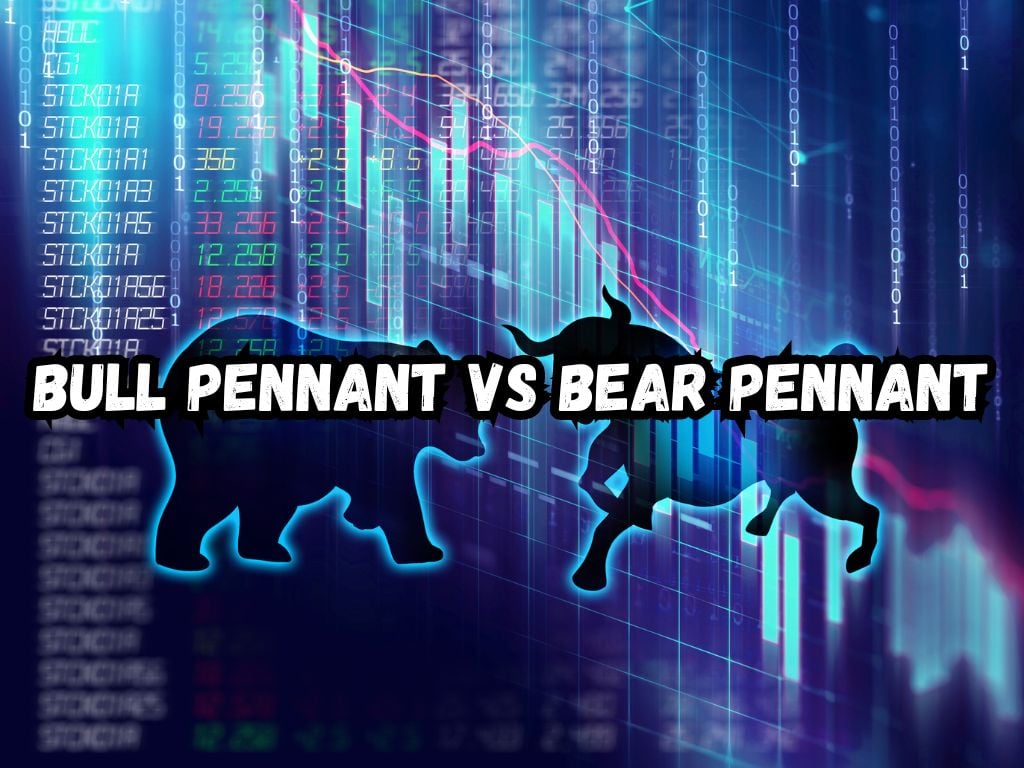In the world of trading and investing, understanding chart patterns is essential. Two significant patterns, the bull pennant and the bear pennant, often indicate continuation trends that can signal upcoming price movements.
This article explores bull pennant vs bear pennant, helping traders and investors recognize and utilize them effectively.
Understanding Pennant
A pennant is a specific chart formation that signals a potential continuation of a previous trend after a brief consolidation. Unlike triangles, pennants are typically shorter in duration and more symmetric.
The psychology behind their formation is key, as they reflect a pause in market momentum before a likely follow-through in the same direction.
Bull Pennant
Definition and Identification
A bull pennant forms in a rising market. It begins with a large climb in price, followed by a consolidation that forms a small symmetrical triangle. The triangle is the “pennant,” consisting of converging upward trend lines.

Formation Process
Bull pennants form due to a pause or pullback in buying after a strong upward move. This consolidation phase often sees reduced volume, which picks up again as the price breaks out to continue the upward trend.
Trading Strategies
Trading a bull pennant involves entering a long position when the price breaks above the pennant formation. Setting stop-loss orders just below the pennant can help manage risk.
Traders should aim to take profits at a price level that mirrors the initial rise preceding the pennant.
Examples
Consider a bull pennant observed in the stock of Company X, which showed a sharp rise from $50 to $70 before forming a pennant. As the price broke above $70 with an increase in volume, it signaled a robust entry point based on the pattern.
Bear Pennant
Definition and Identification
In contrast, a bear pennant forms during a downward trend. It features a sharp decline in price, followed by a period of consolidation with converging downward trend lines.
Formation Process
Bear pennants occur when selling pressure pauses briefly, size and shape are similar to bull pennants, but they slope upward slightly.
Volume typically diminishes in the consolidation phase and intensifies as the breakout occurs downwards.
Trading Strategies
For bear pennants, the trading strategy involves initiating a short position as the price breaks below the lower boundary of the pennant. Stop-loss orders should be placed just above the highest point of the pennant to mitigate risk.
Examples
If the stock of Company Y drops from $100 to $80 and then forms a bear pennantal, a price break below $80 on increased volume could be a good entry point for a short position.
Bull Pennant vs Bear Pennant: Comparison
Both bull and bear pennants serve as continuation patterns but in opposite directions. Each pattern indicates that the market may continue its prior trend post-consolidation. The key to their effectiveness lies in their breakout direction, which must align with their preceding trends.
How to Differentiate Between Pennants and Other Similar Patterns
Flags and wedges can often be confused with pennants. Flags are rectangular and involve parallel trend lines, whereas pennants are small and narrow triangles. Recognizing these differences ensures traders do not misinterpret the patterns.

Risks and Limitations
Relying solely on pennants carries risks. The pattern may not always lead to a continuation of the trend, and false breakouts occur.
Traders should consider other technical indicators and market factors before making any trading decision.
Pro Tips
Improve trading accuracy by combining chart patterns with other forms of technical analysis, such as MACD or RSI. Be prepared for false breakouts by setting appropriate stop-loss points and regularly reviewing trade positions.
Frequently Asked Questions
How long does a typical pennant formation take to develop?
Pennants typically form over a period of one to four weeks, depending on market conditions and the underlying asset.
Can pennants be used for long-term investment decisions or only short-term trading?
While pennants are more commonly used for short to medium-term trading decisions, their principles can be applied in a broader strategic context.
What should I do if the price doesn’t break in the direction indicated by the pennant?
In such cases, it’s advisable to avoid entering a trade based on the pennant until a clear direction is confirmed.
How do volume indicators impact the validity of a bull or bear pennant?
Strong volume during the breakout from a pennant adds credibility to the expected continuation of the trend.
Are there any specific trading platforms or tools that can help identify pennant patterns more efficiently?
Many trading platforms include technical analysis tools that can help identify and analyze pennants and other chart patterns.
Conclusion
Understanding bull and bear pennants is crucial for anyone involved in trading. These patterns can provide valuable insights into future market movements, allowing informed decision-making.
Continued education on chart patterns and cautious trading can yield significant benefits.


 Tags:
Tags:










